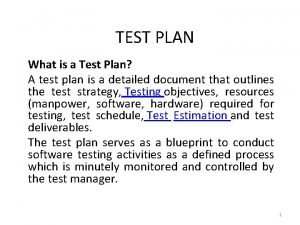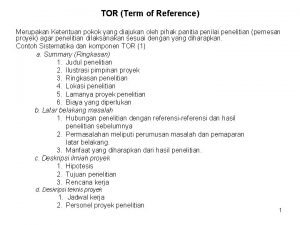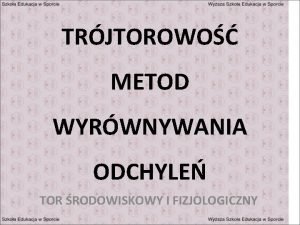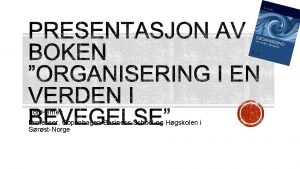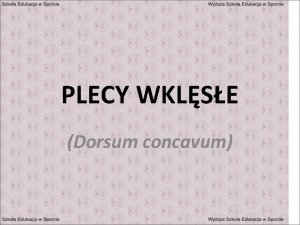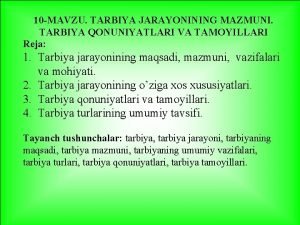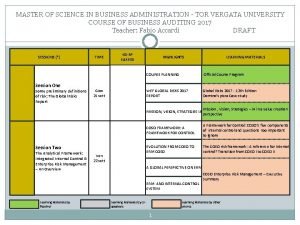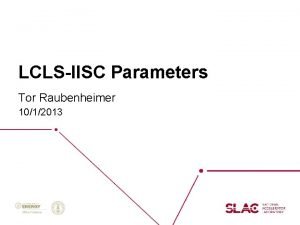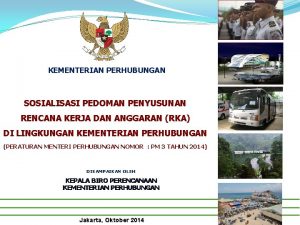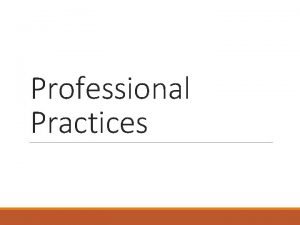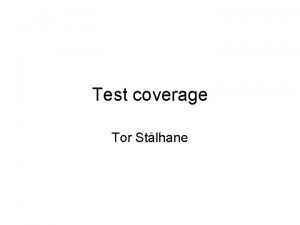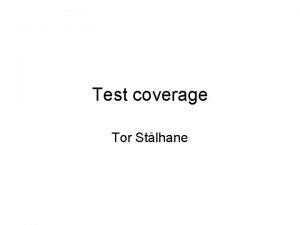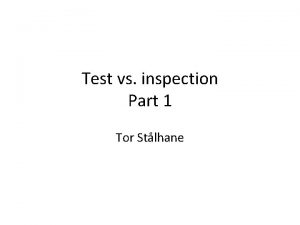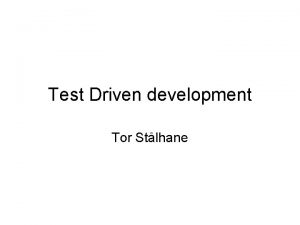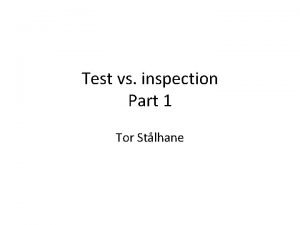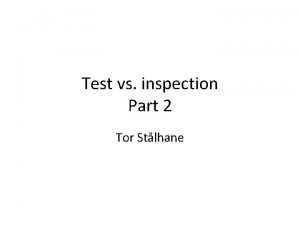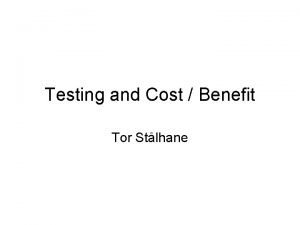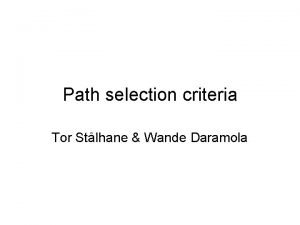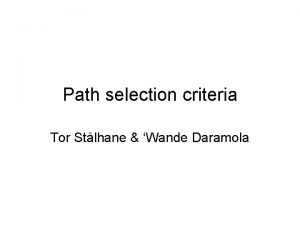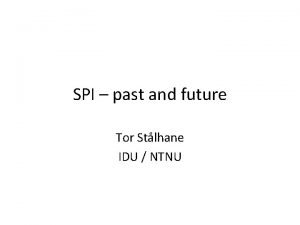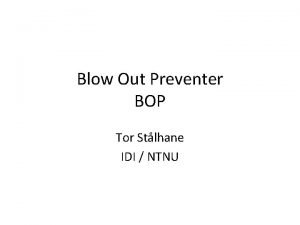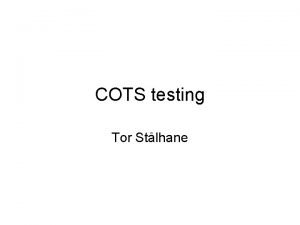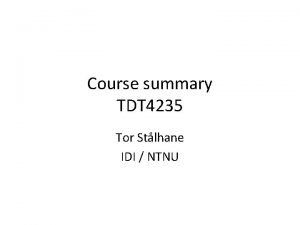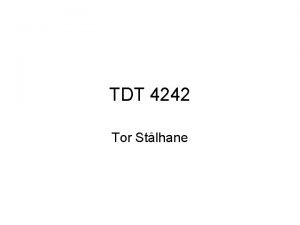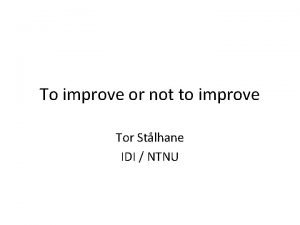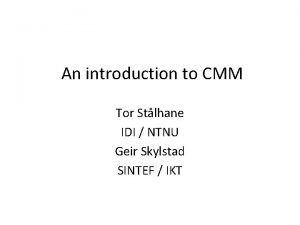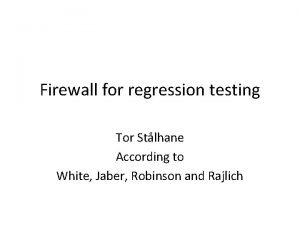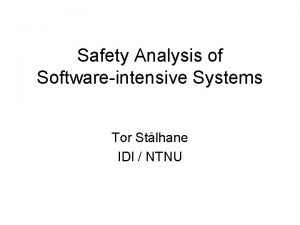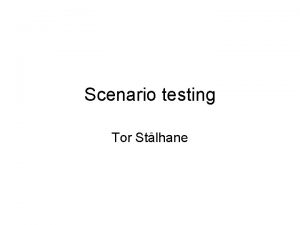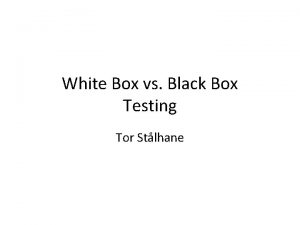Writing a Test Strategy Tor Stlhane Why a
































- Slides: 32

Writing a Test Strategy Tor Stålhane

Why a testing strategy We need a testing strategy to help • System and software testers plus Test-and. Evaluation staff to determine the overall test strategy for development or modification of a software intensive system • Project stakeholders – customers and senior management – approve the test strategy • Testers and system and software analysis to determine – Test objectives – Qualification requirements – Verification and validation criteria

Testing strategy concepts We will discuss the following concepts: • Purpose of a test strategy • Testing focus • Contents of a test strategy • Software integrity levels • Test objectives and priorities

Purpose of a test strategy – 1 The test strategy is important to • Obtain consensus on test goals and objectives from stakeholders – e. g. management, developers, testers, customers and users • Mange expectations right from the start • Be sure that we are heading in the right direction • Identify the type of tests to be conducted at all test levels

Purpose of a test strategy – 2 When we write a test strategy is important to remember that: • Whatever we do some kind of test strategy will emerge. Thus, we might as well specify the one we think is best • A documented strategy is the most effective way to get an early agreement on goals and objectives • We need to address: – Human factors – usability – Interoperability, except for stand-alone systems

Testing focus Our focus will depend on which stakeholder we are considering at the moment: • Users – acceptance test and operational tests • Analysis – systems test, qualification tests • Designer – integration tests • Programmer – unit tests The main point is that we need to define the stakeholder first – then the tests to be run.

Contents of a test strategy – 1 The following is a list of what can be specified in a test strategy. Not all of it is needed in all cases – only use what is necessary. • Project plan, risks and activities • Relevant regulations – depending of application area • Required processes and standards • Supporting guide lines

Contents of a test strategy – 2 • Stakeholders – e. g. users, testers, maintainers – and their objectives • Necessary resources – people, computers • Test levels and phases • Test environment • Completion criteria for each phase • Required documentation and review method for each document

Software integrity level There are several ways to define software integrity levels. When we choose an integrity level this will strongly influence the way we do testing. We will look at three definitions of integrity levels: • IEEE 1012 – general software • ISO 26262 – automotive software • IEC 61508 – general safety critical software

IEEE 1012 – general software • 4, High – some functions affect critical system performance. • 3, Major – some functions affects important system performance • 2, Moderate – some functions effect system performance but workarounds can be implemented to compensate. • 1, Low – some functions have noticeable effect on system performance but creates only inconveniences

V&v Activities V&V activity SW Integrity Level Development requirements level 4 Design level 3 2 1 4 3 2 1 Implementation level Test level 4 4 3 2 1 Acceptance test execution X X X Acceptance test plan X X X Interface analysis X X X X X Management and review support X X X Management review of V&V X X X X 1

ISO 26262 – automotive software The ASIL level – A, B, C or D – is the outcome of the combination of three factors: • S – Severity. How dangerous is a event • E – Probability. How likely is the event • C – Controllability. How easy the event to control if it occurs

Finding the ASIL level Severity S 1 S 2 S 3 Probability C 1 C 2 C 3 E 1 QM QM QM E 2 QM QM QM E 3 QM QM A E 4 QM A B E 1 QM QM QM E 2 QM QM A E 3 QM A B E 4 A B C E 1 QM QM A E 2 QM A B E 3 A B C E 4 B C D

Methods for software integration testing Methods and Measures According to req. ASIL A B C D 1 Requirements based test 9. 4. 4 ++ ++ 2 External interface test 9. 4. 4 + ++ ++ ++ 3 Fault injection test 9. 4. 4 + + ++ ++ 4 Error guessing test 9. 4. 4 + + ++ ++

Methods for software unit testing Methods and Measures According to req. ASIL A B C D 1 Functional tests 8. 4. 2 See table 8. 2 2 Structural coverage 8. 4. 2 See table 8. 3 3 Resource usage measurement 8. 4. 2 + + + 4 Back-to-back test between simulation 8. 4. 2 model and code, if applicable + + ++ ++ ++

IEC 61508 – safety critical software Safety integrity level High demand or continuous mode of operation (Probability of a dangerous failure per hour) 4 10 -9 to 10 -8 3 10 -8 to 10 -7 2 1 10 -7 to 10 -6 to 10 -5 PFDavg = Ft / Fnp. The table above, together with this value decides the SIL level.

Detailed design Technique/Measure SIL 1 SIL 2 SIL 3 SIL 4 HR HR Table B. 7 R HR HR HR 1 c Formal methods including for example, CCS, CSP, HOL, LOTOS, OBJ, temporal logic, VDM and Z 2 Computer-aided design tools C. 2. 4 --- R R HR B. 3. 5 R R HR HR 3 Defensive programming C. 2. 5 --- R HR HR 4 Modular approach Table B. 9 HR HR 5 Design and coding standards Table B. 1 R HR HR HR 6 Structured programming C. 2. 7 HR HR 7 Use of trusted/verified software modules and components (if available) C. 2. 10 C. 4. 5 R HR HR HR 1 a Structured methods including for example, JSD, MASCOT, SADT and Yourdon 1 b Semi-formal methods Ref C. 2. 1 Appropriate techniques/measures shall be selected according to the safety integrity level. Alternate or equivalent techniques/measures are indicated by a letter following the number. Only one of the alternate or equivalent techniques/measures has to be satisfied.

Module testing and integration Technique/Measure 1 Probabilistic testing Ref C. 5. 1 SIL 1 --- SIL 2 R SIL 3 R SIL 4 HR 2 Dynamic analysis and testing B. 6. 5 Table B. 2 R HR HR HR 3 4 Data recording and analysis Functional and black box testing C. 5. 2 B. 5. 1 B. 5. 2 Table B. 3 HR HR 5 Performance testing C. 5. 20 Table B. 6 R R HR HR 6 Interface testing C. 5. 3 R R HR HR a) Software module and integration testing are verification activities (see table A. 9). b) A numbered technique/measure shall be selected according to the safety integrity level. c) Appropriate techniques/measures shall be selected according to the safety integrity level.

Test objectives and priorities Only in rather special cases can we test all input – binary input – output and few parameters. Thus, we need to know • The overall objective of testing • The objective of every test case • The test case design techniques needed to achieve our goals in a systematic way. The test objectives are our requirements specification for testing.

Test data selection One of the important decisions in selecting a test strategy is how to select test data. We will look at five popular methods • Random testing • Domain partition testing • Risk based testing • User profile testing • Bach’s heuristic risk-based testing

Random testing The idea of random testing is simple: 1. Define all input parameters – e. g. integer, real, string 2. Use a random test / number generator to produce inputs to the SUT The main problem with this method is lack of an oracle to check the results against. Thus, manual checking is necessary. The method is mostly used for crash testing (robustness testing) – will the system survive this input?

Domain partition testing – 1 Definitions: • A domain is a set of input values for which the program performs the same computation for every number of the set. We want maximal domains so that the program performs different computations on adjacent domains • A program is said to have a domain error if the program incorrectly performs input classification

Domain testing – simple example If a >< 0, this equation has the following solution Otherwise we have that

Testing domains = 00 a. A>< 0 a. A == 0 D 3 A=0 D 1 D 2 A=0

Risk based testing The idea of risk based testing is to 1. Identify the risk or cost of not delivering a certain functionality. 2. Use this info to prioritize tests. We will cover this in more details later under “Test prioritation”

User profile testing The main idea with this type of testing is to generate tests that mirror the user’s way of using the system. Consider a situation where we know that the users in 80% of all case • Fetch a table from the database • Update one or more info items • Save the table back to the database Then 80% of all tests should test these three actions.

Bach’s risk-based testing Bach’s heuristics is based on his experience as a tester. Based on this experience he has identified • A generic risk list – things that are important to test • A risk catalogue – things that often go wrong We will give a short summary of the first of Bach’s lists.

Bach’s generic risk list – 1 Look out for anything that is: • Complex – large, intricate or convoluted • New – no past history in this product • Changed – anything that has been tampered with or “improved” • Upstream dependency – a failure here will cascade through the system • Downstream dependency – sensitive to failure in the rest of the system • Critical – a failure here will cause serious damage

Bach’s generic risk list – 2 • Precise – must meet the requirements exactly • Popular – will be used a lot • Strategic – of special importance to the users or customers • Third-party – developed outside the project • Distributed – spread out over time or space but still required to work together • Buggy – known to have a lot of problems • Recent failure – has a recent history of failures.

Test and system level – 1

Test and system level – 2 From the diagram on the previous slide we see that we can test on the • Electronics level – e. g. Door. Actuator sends the right signal • State / signal level – e. g. door is closed iff Door. State. Closed • Logical level – e. g. the door remain closed as long as the speed is non-zero • Safety level – e. g. the door remain closed as long as the train is moving

Acknowledgement The first part of this presentation is mainly taken from Gregory T. Daich’s presentation “Defining a Software Testing Strategy”, 30 April 2002.
 Hey bye bye
Hey bye bye Dont ask
Dont ask Test plan guru
Test plan guru Freja asagud fakta
Freja asagud fakta Roger dingledine nick mathewson
Roger dingledine nick mathewson Bentuk tor
Bentuk tor Tor topografyası
Tor topografyası Trachearendszer
Trachearendszer Traumdeutung tor
Traumdeutung tor Brandenburger tor alexanderplatz
Brandenburger tor alexanderplatz Fazy reedukacji posturalnej
Fazy reedukacji posturalnej Tor morfologiczny
Tor morfologiczny Bolalar kasalliklari reabilitasiya
Bolalar kasalliklari reabilitasiya Roger dingledine nick mathewson
Roger dingledine nick mathewson Tor hernes
Tor hernes Roma school of economics (tor vergata)
Roma school of economics (tor vergata) Tor morfologiczny
Tor morfologiczny Infrastruktura komunikacyjna definicja
Infrastruktura komunikacyjna definicja Infn roma tor vergata
Infn roma tor vergata Das brandenburger tor
Das brandenburger tor Tarbiya va uning turlari
Tarbiya va uning turlari Tor terra
Tor terra Ib brandenburger tor
Ib brandenburger tor Tor master
Tor master Master business administration tor vergata
Master business administration tor vergata Tor raubenheimer
Tor raubenheimer Tor data pendukung rka-k/l disusun pada tataran
Tor data pendukung rka-k/l disusun pada tataran Indisk eldgud
Indisk eldgud Tor medalen
Tor medalen Davide lauro
Davide lauro Abstand elfmeterpunkt tor
Abstand elfmeterpunkt tor Term.of reference
Term.of reference Ich will einziehn in sein tor
Ich will einziehn in sein tor


